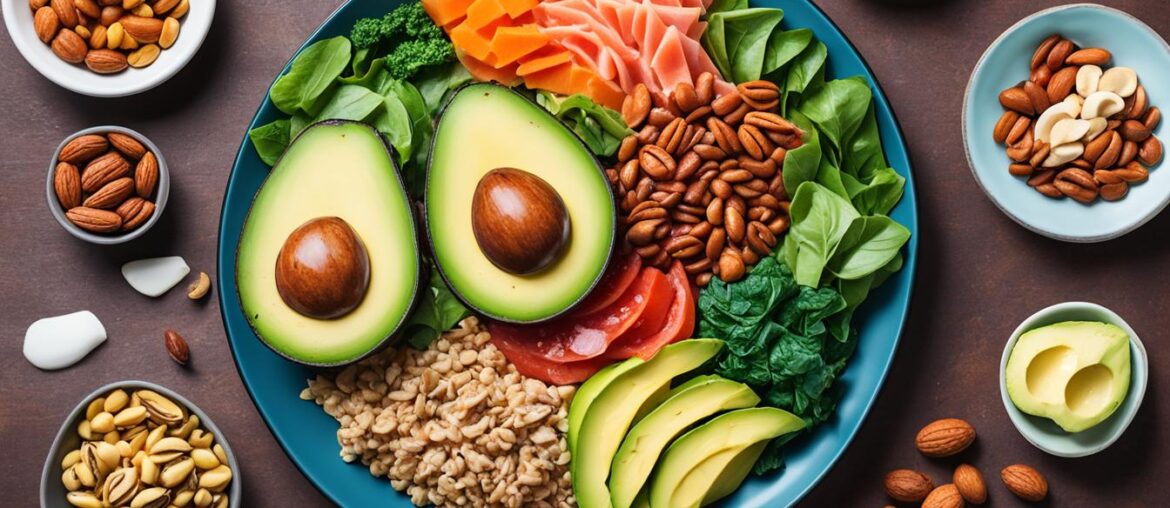When it comes to achieving optimal weight loss on the keto diet, understanding the right macros is key. Tracking your keto diet macros can help you stay on track and reach your weight loss goals effectively. In this guide, I’ll explain everything you need to know about keto diet macros, including how to calculate them, track them, and make the most of your ketogenic diet for weight loss.
Before we dive in, let’s clarify what exactly keto diet macros are. Macros, short for macronutrients, refer to the three main nutrients that make up our diet: carbohydrates, fats, and proteins. The key to the keto diet is adjusting these macros to encourage your body to enter a state of ketosis, where it burns fat for fuel instead of carbohydrates.
How the Keto Diet Works for Weight Loss
The ketogenic diet, commonly known as the keto diet, is a popular eating pattern that has gained recognition for its potential to promote weight loss. Understanding how the keto diet works for weight loss can help individuals make informed decisions about whether it is a suitable approach for their goals.
The key principle behind the keto diet is to shift the body’s primary source of fuel from glucose to fat. Normally, the body relies on carbohydrates for energy, which are converted into glucose. However, when carbohydrate intake is significantly reduced, the body enters a metabolic state called ketosis.
In ketosis, the body starts to burn stored fat for energy instead of glucose. This process is achieved by limiting carbohydrate intake and increasing the consumption of healthy fats. By depriving the body of its usual glucose supply, a ketogenic diet forces the body to break down fat stores into ketones, which are then used as an alternative fuel source. This shift from burning glucose to burning fat for energy is what makes the keto diet effective for weight loss.
Beyond its impact on energy metabolism, the keto diet may also have other weight loss benefits. For starters, the increased fat consumption on a keto diet can help reduce hunger and cravings, making it easier to adhere to a calorie-controlled eating plan. Additionally, ketosis has been associated with increased metabolism, leading to more calories burned even at rest.
However, it’s worth noting that the keto diet may not be suitable for everyone. It requires careful planning and a commitment to following a low-carb, high-fat eating pattern. The transition into ketosis can also cause temporary side effects, such as fatigue and brain fog, known as the “keto flu.” It’s important to consult with a healthcare professional before starting the keto diet to ensure it aligns with individual health needs and goals.
In summary, the keto diet works for weight loss by promoting a state of ketosis, where the body burns fat for fuel instead of glucose. By limiting carbohydrate intake, increasing fat consumption, and producing ketones, the keto diet can help individuals burn stored fat and achieve their weight loss goals. However, it’s important to approach the keto diet with caution and consult with a healthcare provider. As with any dietary approach, individualization and careful consideration of overall health should always be prioritized.
How to Calculate and Track Macros on the Keto Diet
Calculating and tracking macros on the keto diet is essential for achieving optimal weight loss. By understanding and monitoring your macronutrient intake, you can ensure that you are following the right balance of carbohydrates, fats, and proteins to support ketosis and promote effective weight loss.
To start, you need to calculate your macros based on your specific weight loss goals. This process involves determining your calorie needs and then allocating those calories to the appropriate macronutrients to create your desired macro ratio.
“Calculating macros allows you to tailor your diet to your individual needs and make sure you’re fueling your body correctly.”
There is a simple equation you can use to calculate your calorie needs for weight loss. It takes into account your basal metabolic rate (BMR), which is the number of calories your body needs to function at rest, and your activity level.
Once you have your calorie goal, you can determine the grams of carbohydrates, fats, and proteins you should be consuming each day. The macro ratio traditionally recommended for the keto diet is approximately 5% carbohydrates, 75% fats, and 20% proteins. However, individual ratios may vary based on factors such as personal preferences, activity levels, and health goals.
Tracking your macros is crucial to ensure you stay within your desired ranges. There are various methods you can use to track your macros, including manually recording your food intake or using a macro tracking app. These apps make it easy to log your meals and provide a breakdown of your macro consumption, allowing you to make adjustments as needed.
Benefits of Calculating and Tracking Macros on the Keto Diet
Tracking macros on the keto diet offers several benefits:
- Ensures proper macronutrient balance: By tracking your macros, you can ensure you’re consuming the right amount of carbohydrates, fats, and proteins to maintain ketosis and support weight loss.
- Increases awareness of food choices: Tracking macros encourages mindful eating and helps you make informed decisions about the foods you consume, leading to healthier choices.
- Allows for flexibility: Tracking macros allows you to customize your diet based on your preferences and needs while still following the principles of the keto diet.
Sample Keto Diet Macro Calculation:
| Macronutrient | Calories per gram | Daily Grams (based on a 2,000-calorie diet) |
|---|---|---|
| Carbohydrates | 4 | 25 grams (5% of calories) |
| Fat | 9 | 167 grams (75% of calories) |
| Protein | 4 | 100 grams (20% of calories) |
Keep in mind that these values are just a sample calculation based on a 2,000-calorie diet. Your specific macronutrient needs may differ depending on your individual goals and physiological factors. It’s always a good idea to consult with a healthcare professional or registered dietitian to determine the optimal macronutrient breakdown for your unique needs.

Benefits and Pitfalls of the Keto Diet for Weight Loss
The keto diet has gained popularity as a weight loss strategy due to its ability to induce ketosis, a metabolic state where the body burns fat for fuel instead of carbohydrates. While the keto diet has its benefits, it also comes with potential pitfalls that individuals should be aware of. Let’s explore the benefits and pitfalls of the keto diet for weight loss.
The Benefits of the Keto Diet for Weight Loss
The keto diet has been shown to have several benefits for weight loss. Firstly, it can lead to rapid initial weight loss, primarily due to a reduction in water weight. Additionally, the high-fat and low-carb nature of the diet may help to reduce appetite, leading to a lower calorie intake. Furthermore, the keto diet has been found to improve insulin resistance and blood sugar control, which can be beneficial for individuals with type 2 diabetes.
“The keto diet’s ability to burn fat for fuel can be advantageous for individuals looking to lose weight and improve their overall health.”
The Pitfalls of the Keto Diet for Weight Loss
While the keto diet may offer benefits for weight loss, there are also potential pitfalls to consider. One common challenge is the experience of keto flu, which includes symptoms such as fatigue, headache, and constipation. These symptoms typically occur during the initial adaptation phase as the body transitions into ketosis.
Another potential pitfall of the keto diet is the risk of nutrient deficiencies. Since the diet restricts many high-carb foods, it’s essential to ensure an adequate intake of vitamins, minerals, and fiber from other sources. Incorporating a variety of keto-friendly foods such as leafy greens, nuts, and seeds can help mitigate this risk.
Safety and Considerations of the Keto Diet for Weight Loss
The keto diet is generally considered safe for most individuals, but there are some important considerations to keep in mind before starting this eating plan.
Type 1 Diabetes and Certain Medical Conditions
It’s important to note that the keto diet may not be suitable for individuals with type 1 diabetes or certain medical conditions that interfere with normal protein and fat metabolism. Consulting with a healthcare provider is essential for those with these conditions to determine if the keto diet is safe and appropriate for them.
Pregnancy and Rapid Growth Periods
Pregnant women and individuals in periods of rapid growth, such as children and adolescents, may have increased nutrient needs that are restricted on the keto diet. It’s crucial to ensure adequate intake of essential nutrients for the healthy development of the fetus or during these growth phases. Always consult with a healthcare provider for personalized recommendations.
Long-Term Effects and Nutrient Deficiencies
Although the keto diet has shown promising short-term weight loss and health benefits, its long-term effects are still being studied. More research is needed to fully understand the safety and potential risks of following the keto diet for an extended period. Additionally, the restrictive nature of the diet may increase the risk of nutrient deficiencies if a wide variety of nutrient-rich keto-friendly foods are not included in the meal plan. It’s important to emphasize a balanced and diverse diet to ensure adequate intake of all essential nutrients.
Conclusion
The keto diet can be an effective strategy for weight loss, providing short-term benefits such as a reduction in weight and improvements in health markers. However, it’s important to note that the keto diet may not be suitable for everyone. Before embarking on any new diet, including the keto diet, it is crucial to consult with a healthcare provider to ensure its safety and appropriateness.
While the keto diet focuses on macronutrient ratios, it’s equally important to consider the quality of food and prioritize a well-rounded diet for long-term weight management and overall health. A balanced and sustainable approach to weight loss involves incorporating a variety of nutrient-rich foods into one’s meal plan. This ensures the body receives an adequate intake of essential vitamins, minerals, and fiber.
In conclusion, the ketogenic diet can offer initial weight loss success and improvements in certain health markers. However, it is essential to approach it with caution and prioritize overall dietary balance. Consulting with a healthcare professional and focusing on long-term, sustainable dietary habits is crucial for achieving healthy weight management and overall well-being.
FAQ
What are the macro breakdowns for the keto diet?
The macro breakdown for the ketogenic diet typically involves restricting carb intake to 5% to 10% of calories, increasing fat intake to 55% to 60% of calories, and allocating 30% to 35% of calories to protein.
How does the keto diet work for weight loss?
The keto diet works by depriving the body of glucose and triggering the production of ketones from stored fat. When carb intake is low, the body switches to burning fat for fuel, leading to weight loss.
How do I calculate and track macros on the keto diet?
To calculate macros, determine your calorie needs for weight loss using your basal metabolic rate (BMR) and activity level. Once you have your calorie goal, determine the grams of carbs, fat, and protein you need based on your desired macro ratio. Track your daily intake using a macro tracking app.
What are the benefits and pitfalls of the keto diet for weight loss?
The keto diet can lead to short-term weight loss and improvements in health markers. However, it can be challenging to maintain and may cause symptoms of the keto flu and nutrient deficiencies if not followed properly.
Is the keto diet safe for everyone?
The keto diet may not be suitable for individuals with certain medical conditions or those in periods of rapid growth. Pregnant women and people with type 1 diabetes should approach the diet with caution. More research is needed to fully understand the long-term effects and safety of the keto diet.
What should I consider before starting the keto diet for weight loss?
It’s important to consult with a healthcare provider before starting any new diet, including the keto diet. While the keto diet may provide short-term benefits, it’s important to focus on overall diet quality and include a variety of nutrient-rich foods for long-term weight management and health.




